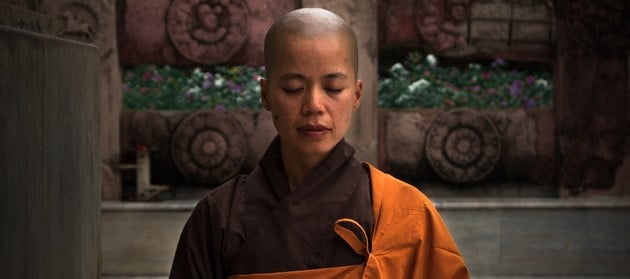
How to learn meditation. This text is particularly suitable for experienced practitioners. You can find a more comprehensible overview for getting started with meditation here – 10 tips for meditation .
Contents
- Learning meditation is difficult!
- How to learn meditation?
- What meditation is not …
- What meditation is …
- Why learn meditation?
- The definition of mind
- Thoughts are like waves
- Train the mind
- Relaxation > Concentration > Meditation
- Relaxation
- Concentration
- Flow
- First steps into the unknown
- Meditation
- Meditation and daily life
- Hello darkness my old friend
- Instructions for meditation
How to learn meditation and why it is not difficult!
How to learn meditation is often a closed book for beginners. Countless guidebooks contain various meditation techniques that provide relaxation, but the positive transformation fails to materialize because we only scratch the surface. We are left with the frustrated feeling that meditation as an experience is closed and mysterious. We gain the impression that meditation cannot really be compatible with daily life.
If we then decide to take the disciplined step of meditating as much as possible every day, we also achieve success with the first sessions, we become calmer and can cope better with the demands of everyday life. The first deeper insights become apparent. As we progress, we encounter unpleasant thoughts, the volatility of our mind and tiredness during the sessions. There seems to be no right or wrong approach. Then comes the question – am I meditating at all? Frustrated, we give up and move on to more accessible techniques to achieve inner peace.
Even after years of practicing meditation, irritations and changes occur. Meditation is a continuous process and no two meditation sessions are the same. Even the process of initial successes and frustration is part of it. We enter an open field without a map in which there is no right or wrong. Meditation is involved in our everyday lives like no other spiritual technique. Far from floating in heavenly peace far away on a cloud, it is exactly the opposite. It is about developing an inner attitude of acceptance for the situations we go through in life. This article explains emerging irritations during meditation, the basic technique and the first signs of a successful meditation practice. Anyone can learn meditation and experience its healing power.
How to learn meditation?
Learning to meditate is an ongoing process. In addition to numerous scientific and spiritual texts on meditation, only individual, practical experience can lead to an understanding of meditation. Our experiences and challenges in life are just as much a part of learning to meditate as the practice of meditation itself. Meditation and everyday life are constantly interrelated. Getting to grips with the basic technique at an early stage motivates a steady meditation practice. This article outlines the core elements that give the meditator a direction.
What meditation is not …
Meditation is not sitting relaxed with your eyes closed for a long time. Nor does it ensure that difficulties in life are simply swept out of the way. It is not a place where expectations are fulfilled or where everything automatically becomes easier. Meditation is not a standstill.
What meditation is …
Meditation means becoming mentally strong. It is the way to drop even the expectations and results through meditation. It means reducing the dependence of external circumstances on our mental state. Learning to meditate means being more loving towards the world and yourself. It means bringing light into the inner self and finding a home there again.
Why learn meditation?
In an age of countless information, entertainment options and the resulting scattered concentration of our attention, our minds become restless. The natural balance of consciousness, emotions and thoughts is disturbed. Despite our free will, it is the conditioned impulses of our subconscious that determine our actions and reactions. Scientifically speaking, the subconscious mind controls 95% of our daily actions and 5% of our active consciousness. 1

This is why we have the feeling that we are at the mercy of our impulsive thoughts, as they emerge uncontrollably from the subconscious. This results in additional reflexive actions that we perform as soon as a thought prompts us to do so. We may have misjudged the situation because our brain is trying to warn us of a danger. However, this does not exist or does not have the degree of drama that we assign to it. This leads to further disturbances in the subconscious and a cycle of further thoughts. Meditation cleanses the subconscious mind by dissolving the deep-seated blockages in the subconscious. New neural connections are created in the brain, through which we can free ourselves from this cycle.
“How does everyday, unwanted suffering that we try to prevent come from our own minds? It arises because our mind is not under our control; we are under the control of our mind, which in turn is under the control of our disturbing thoughts.”²
Lama Zonpa Rinpoche
The definition of mind
The mind is the summary of our consciousness, subconscious, emotions and thoughts. It is responsible for giving meaning to our environment and connects the outer world with our inner world. As a tool, the mind is an all-round talent with virtually no limits. Goals that are difficult to achieve can be turned into reality through mental visualization. The mind makes it possible to direct our thoughts, emotions and consciousness towards goals in life. Conversely, this character of the mind also causes unrest through the evolutionary classification of problems and solutions in our environment. Thoughts categorize situations into pleasant, unpleasant, past and future. This results in personal rejection and attachment to thoughts and emotions that are constantly repeated. Stress arises. The first approach here is to focus on an object of meditation in order to train the mind to constantly align itself in the long term..
Summary
- Meditation is a continuous process
- Blockages in the subconscious and negative thoughts can make us ill
- The mind is constantly searching for a task
- We use a meditation object to calm the mind and dissolve blockages
Thoughts are like waves
If we are tense due to too much stress, the mind can become tense like a guitar string pulled tight. If such a string is loose and we pull on it, hardly any sound is produced; if the string is taut, a high-pitched sound is produced. Thought waves are created in the same way when the mind is tense. It becomes problematic when we identify too strongly with these thoughts and emotions and the waves wash over us.

Thoughts are subject to the same phenomenon as waves. They appear and disappear again. It is important to experience this characteristic in meditation so that we can free ourselves from the illusion of the importance of thoughts. It is necessary to understand that we cannot completely control the mind and that this is not necessary. Neither do we need to suffer from its fluctuations. Theoretical understanding alone will not get us far here. The pure experience of perceiving thoughts and letting them go in meditation frees us from the cycle of reflexive behavior.
“Every sensation has the same property – it arises and passes away, arises and passes away. It is this arising and passing away that we have to experience through meditation practice, not just accept it as truth because Buddha said so, not just accept it because it seems intellectually logical enough. We have to experience the nature of sensation, understand its flow and learn not to react to it.”
S.N.Goenka
Training the mind
To bring the mind into balance, we use its natural predisposition to connect with objects. We achieve this through long-term concentration on an object. To do this, we need strong concentration. As with strength training, stable concentration gives the mind the ability to focus on an object without interruption. This results in a calming of impulsive thought patterns. A persistent ability to concentrate is helpful in all areas of life and reduces unnecessary wandering of the mind. It is important to choose an object of meditation that the mind likes to focus on. Put simply, an object of meditation that appeals to us personally and is interesting enough to focus on in the long term.
Relaxation > Concentration > Meditation
When we paint a room, we find it all the easier if we have done the appropriate preparatory work. For example, masking the surfaces and mixing the paint. It’s the same with meditation. The quality of relaxation determines the quality of concentration and this determines the quality of meditation. This sequence builds on each other. Relaxation is so crucial, because in a tense state we hardly develop any concentration, but constantly wander off. The harder we try to forcibly steer the mind in one direction, the more restless the mind becomes. It is the balance of both aspects – relaxation and concentration – that makes meditation possible. By practicing these aspects regularly, meditation gains depth and quality.
Learn meditation through relaxation
Relaxation is the first important step in learning meditation. Relaxing a restless mind is not easy. Irritatingly, the mind has a tendency to become even more restless when we actively try to relax it. Similar to actively trying to fall asleep. Like a tamer who knows the daily form of his tiger, the experienced meditator therefore chooses to focus on relaxation or concentration in order to achieve a good balance. We make use of the mind-body connection here and focus the mind on a relaxed breath and body. In doing so, we connect alignment with an object (body) and relax the mind at the same time.

We start by relaxing the body through body scans or asanas. A straight back is important when sitting for meditation. This prevents drowsiness and increases awareness. If necessary, you can also lean against the wall with a cushion or sit on a chair. Once we have found a suitable sitting position with an upright posture, we can calm the mind through breathing techniques. We move from the gross to the subtle, step by step. Once the body and breath are relaxed, we have created the first foundation for meditation.
Concentration
Concentration means an uninterrupted focus on an object for an extended period of time. To learn meditation, we try to develop concentration with quality. If we hold the object too tightly, we quickly become tired; if we hold it too loosely, no long-term connection is established. A gentle and constant focus on the meditation object over a longer period of time creates the desired flow between mind and object. With time and sufficient training, we manage to focus on an object for longer periods without interruption until a flow is created. We enter into meditation.
Concentration is the focus of consciousness on one point (an object, an idea). Meditation is the uninterrupted flow of consciousness in the direction of the object presented to it. Samadhi ( deep meditation ) is when the object alone still appears in its essence, as if it were without form⁴
Patanjali
Summary
- Thoughts come and go
- Through long-term non-attachment to thoughts, the mind enters meditation
- Concentration and relaxation can be trained
- The quality of concentration and relaxation (flow) form the basis for meditation
Flow
Flow is a mental state of focus and deep relaxation in balance. It is also one of the first signs of meditation. As a surfer, skateboarder or artist, it takes prolonged training with an object to create flow. This happens through a prolonged period of relaxed concentration on one and the same activity. The action has already become so ingrained that it practically happens by itself. At the same time, a subtle connection to the action remains. The same process describes the transition from concentration to meditation – the flow between mind and object.

First steps into the unknown
Meditation can be difficult because thoughts and emotions start racing as soon as you sit down. At the beginning, the mind wavers between exhaustion or boredom. It seems impossible to focus on one object in the long term. We wanted to get a grip on this and not make it worse. Meditation is not a practice to escape from inner processes, but to light a candle here. It can be frightening at first when we clearly see how unreliable and deceptive our thoughts are. Our training is to counter these fluctuations with a relaxed attitude. This change in behavior takes time and requires patience with ourselves. It is important to set yourself small goals. Even 10 minutes of meditation a day can lead to amazing results over a longer period of time.
By training with a meditation object, we quickly restore our ability to focus on an object over the long term. It is extremely helpful here that practitioners enjoy focusing on the meditation object. You should meditate just enough to make you look forward to the next session. Having fun is just as important here as with any other activity that you want to learn.
Meditation
In meditation, we need neither the object of meditation nor any effort or “doing”. What remains is pure consciousness. Such a state defies any theoretical description or definition – that is what makes it so powerful. In meditation, nothing else matters, not even meditation. The first signs of meditation are an awareness of clarity, love, joy and at the same time deep detachment.
Meditation and daily life
We usually come to a meditation practice through problems and exhaustion. We learn to relax and thereby gain new concentration and strength. We quickly develop the quality and balance we were looking for. Then everyday life follows and everything starts all over again. We try to hold on to our meditative posture, but it doesn’t work and we become frustrated. As a result, we turn meditation into a foreign body in our lives.

Life is stressful and brings out inner processes in us from the subconscious that we are reluctant to confront. Meditation actually reinforces this process, as we can now allow these inner processes to take place. We can see more clearly how we react and what is going on inside us. This constant alternation of stress and relaxation of our mind brings quality and depth to our practice. How would we ever know if our meditation is successful if we don’t strain our mind in everyday life? Leather also gains quality through stress and regular care, and it is the same with our mind.
Hello darkness my old friend
Facing heavy emotions and thoughts is not easy. It is important to learn patience through meditation and to work with your own limits. Mental pain can be far more powerful than a physical injury. Anyone who decides to start meditating will encounter difficult emotions at some point along the way. Our normal reaction in everyday life is to hold on to pleasant thoughts and emotions and block unpleasant ones. During meditation, we do not make a choice but accept all thoughts and emotions. We let them pass by without holding on to them. This non-reaction seems almost impossible at first, as the conditioning to identify with them is very deep-seated.

In order to break this cycle of self-sabotage and depressive thoughts in the first place, it is necessary to meditate on this cycle. This means not trying to actively block the negative thoughts, which gives them even more energy. Once we have given ourselves some breathing space, we can perceive these thoughts more clearly. Rain clouds form and then dissipate again. Even if the sky is completely covered, we know that it is always there.
Summary
- Long-lasting and relaxed concentration on a meditation object creates flow and thus meditation
- Meditation can be fun
- Meditation requires perseverance and determination
- Inner and outer conflicts are equivalent to happy and peaceful experiences
- Everyday life is the playing field and meditation is our preparation
.
Instructions for meditation
- Sit comfortably in a position with a straight back where you can sit for a long time. A chair is also okay. Start with a relaxation technique that works for you and that you feel comfortable with.
- Now concentrate on a mantra, your breath or a meditation object of your choice. Now focus your senses on the object. Thoughts will arise in between. Then concentrate on the object again when you find yourself again. Do not become frustrated, but gently return to the object and focus on it.
- After prolonged practice of focusing on an object that is pleasant and interesting enough for your mind, this connection will exist almost by itself. Without breaking the connection, you can continue to relax and reduce attachment further without losing the object. The mind remains attached to the object and we sink back into ourselves as our attention increases. Meditation begins at this stage.
- After a while, we come out of this state and focus on the object again and start all over again. Meditation is like a stock market price, it goes up and down all the time. The act of sitting down and repeating the technique over and over again. Relaxing, concentrating and letting go is the basic sequence for learning meditation.
- No meditation session is the same. When we learn to let go of our expectations and enjoy the process, we have already taken a big step. Then when we get into meditation for the first time, we will intuitively know what to do.
Zitate
1 https://www.spektrum.de/frage/verarbeitet-das-gehirn-95-prozent-aller-informationen-unbewusst/1616926
2 https://www.lamayeshe.com/article/chapter/chapter-1-finding-peace-everyday-life-lama-zopa-rinpoche
3 https://www.azquotes.com/author/22607-S_N_Goenka
4 Loslössung. S. 290Patanjalis Yoga Sutra